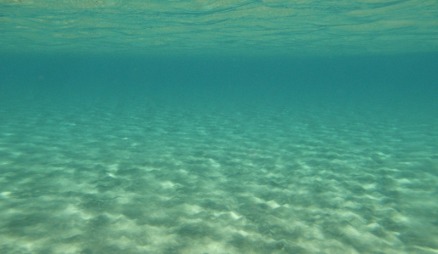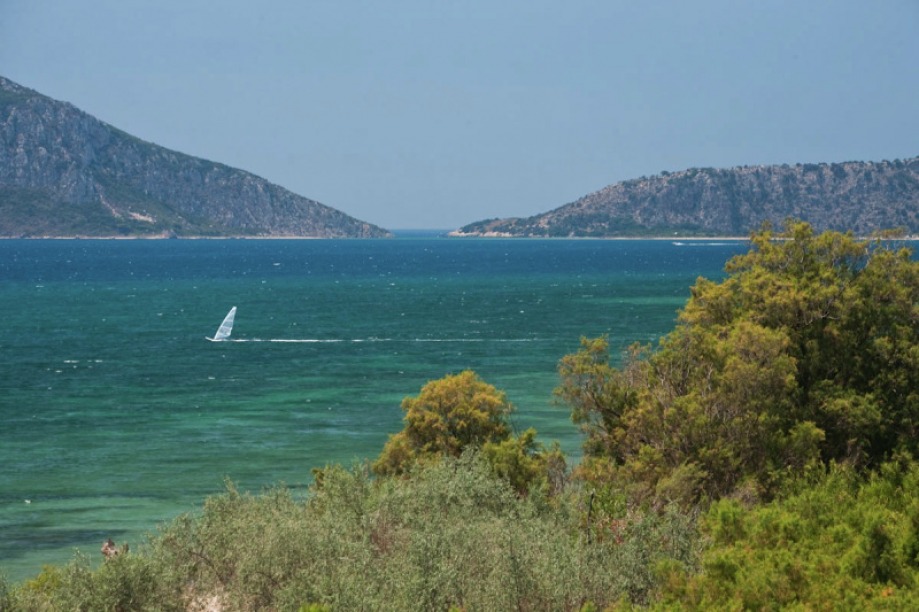The area around Zoe Resort
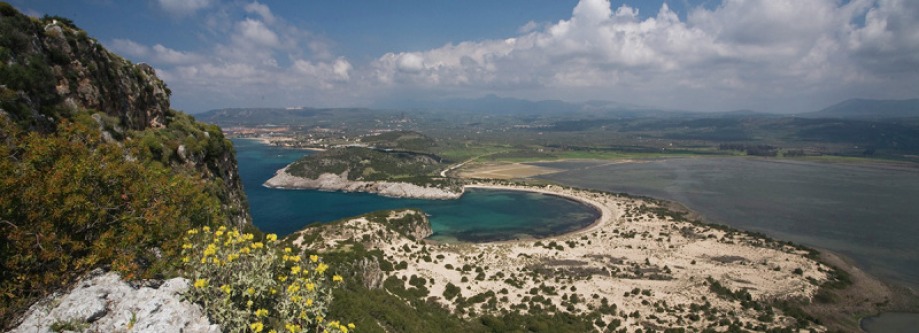
The area of Gialova and Pylos hides wonderful places, including the unique Voidokilia beach
From either a historical, a cultural or an environmental point of view, Pylos and the area surrounding it is one the most interesting parts of Greece. The Navarino Bay - at the shores of which Pylos and Gialova are situated - was the setting for the Battle of Navarino on October 20th 1827, in which the Turkish fleet was defeated and which finally freed Greece from the Turks. The wrecks of the Turkish vessels can still be seen at the bottom of the bay. The massive mast of one of these vessels can be seen in the cafe building of the Zoe Resort.
The area around Gialova and Pylos has some of the finest beaches in the Peloponnese, if not Greece. At most of the beaches the sand slopes gently into the clear, blue water of Navarino Bay. Voidokilia Beach, just a short walk away along the beach from Zoe Resort, has been listed among the 25 most beautiful beaches of Europe.
The area around Gialova and Pylos has some of the finest beaches in the Peloponnese, if not Greece. At most of the beaches the sand slopes gently into the clear, blue water of Navarino Bay. Voidokilia Beach, just a short walk away along the beach from Zoe Resort, has been listed among the 25 most beautiful beaches of Europe.
The Navarino Bay
The water of the Navarino Bay is the ideal location for water sports like windsurfing, kite-surfing, sailing or canoeing and if you want to have a look around the area, scooters and bicycles can be rented in the village, while cars rentals are found in the nearby town of Pylos.
The water of the Navarino Bay is the ideal location for water sports like windsurfing, kite-surfing, sailing or canoeing and if you want to have a look around the area, scooters and bicycles can be rented in the village, while cars rentals are found in the nearby town of Pylos.
Medieval Castles
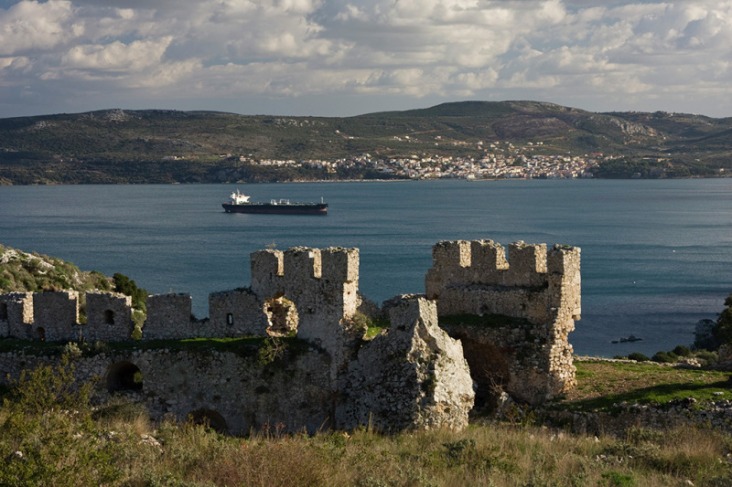
Paleokastro, with the Navarino Bay and Pylos in the background
In the area of the Southwestern Peloponnese there are several Frankish, Turkish and Venetian castles, some of them remarkably well preserved, like the Paleokastro and Neokastro (translated into old and new castles) of Pylos, and the castles of Methoni and Koroni.
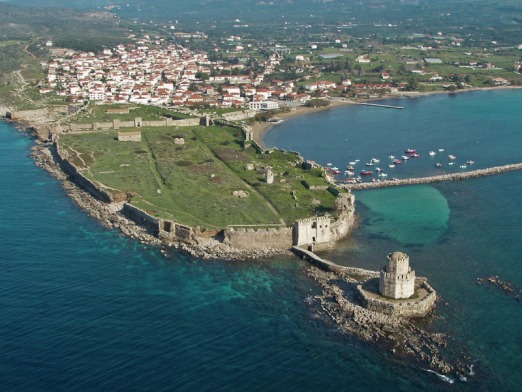
Methoni fortress
Mycenean Pylos
The palace of the legendary King Nestor, the great Mycenaean hero of the Homeric Iliad, lies just 9 km from Zoe Resort. Ancient Pylos, Nestor's town, is said to be hidden under the sand of magnificent Voidokilia beach, just a short walk away along the beach from the hotel. And in the rocks above Voidokilia right below the Paleokastro, you can find Nestor's cave, where according to mythology the god Hermes hid the cows stolen from his divine brother Apollo.
The palace of the legendary King Nestor, the great Mycenaean hero of the Homeric Iliad, lies just 9 km from Zoe Resort. Ancient Pylos, Nestor's town, is said to be hidden under the sand of magnificent Voidokilia beach, just a short walk away along the beach from the hotel. And in the rocks above Voidokilia right below the Paleokastro, you can find Nestor's cave, where according to mythology the god Hermes hid the cows stolen from his divine brother Apollo.
Pylos
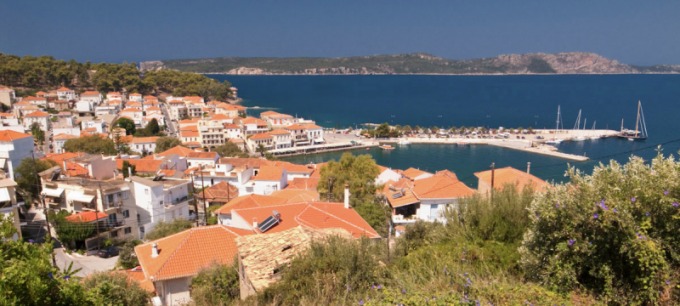
Pylos and its small port on the Navarino Bay
The small town of Pylos was built on the southern shores of the Navarino Bay. It has always been an important port of the western Peloponnese since at least the Middle Ages. Today it is a quiet town that becomes alive during the summer season when tourists and Athenians arrive to spend their holidays.
Pylos is a delightful town, with its waterfront tavernas and its beautiful central square which is surrounded by cafés and were you can have an “Ellenikós Káfe” in the shade of an enormous Plane tree. On the square you will also find a memorial commemorating the Battle of Navarino of 1827, in which the Turkish fleet was destroyed.
The Neokastro or fortress is definitely worth a visit. It was built by the Turks in the 16th century, but during the last two centuries it served as a prison. You can have a walk around the battlements. Inside the Neokastro you will also find a beautiful church and a small museum.
From the port you can make a boat-trip to the uninhabited island of Sfaktiria, just across the bay. Here you can see a small wooden Russian-orthodox church which was built as a memorial to the Russian sailors who fought in the Battle of Navarino.
Pylos is a delightful town, with its waterfront tavernas and its beautiful central square which is surrounded by cafés and were you can have an “Ellenikós Káfe” in the shade of an enormous Plane tree. On the square you will also find a memorial commemorating the Battle of Navarino of 1827, in which the Turkish fleet was destroyed.
The Neokastro or fortress is definitely worth a visit. It was built by the Turks in the 16th century, but during the last two centuries it served as a prison. You can have a walk around the battlements. Inside the Neokastro you will also find a beautiful church and a small museum.
From the port you can make a boat-trip to the uninhabited island of Sfaktiria, just across the bay. Here you can see a small wooden Russian-orthodox church which was built as a memorial to the Russian sailors who fought in the Battle of Navarino.
Day-trips from Zoe Resort
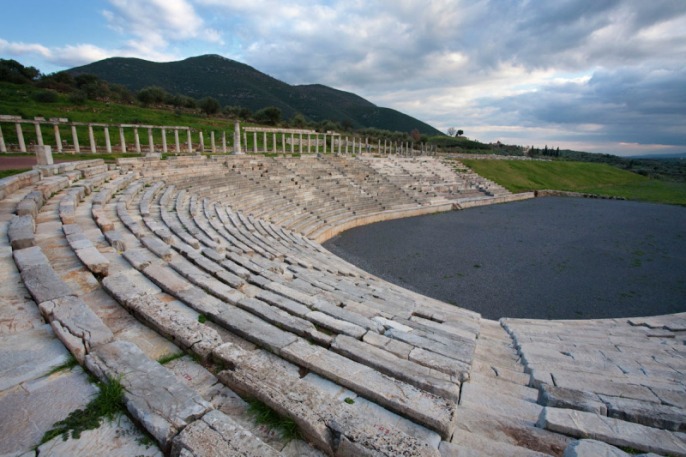
Ancient Messini
Besides the area immediately around Gialova and Pylos, other very interesting ancient sites like Olympia, Sparta, Mystrás, ancient Messini and the Diros caves can be visited in a day-trip.
Gialova is the ideal starting-point for excursions to many of the archaeological sites that are scattered around the Peloponnesian peninsula. On this page we will give you a few hints for your sight-seeing trips. It is just a small selection out of all the sites you can visit around the Peloponnese.
Gialova is the ideal starting-point for excursions to many of the archaeological sites that are scattered around the Peloponnesian peninsula. On this page we will give you a few hints for your sight-seeing trips. It is just a small selection out of all the sites you can visit around the Peloponnese.
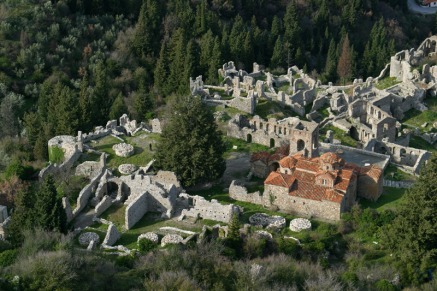
Mystras
Mystrás
Imagine an amazingly intact Byzantine city, stuck against a steep hillside, with winding alleys, monumental gates and arches, medieval houses, palaces and churches, and you have a picture of Mystrás. Wander through Mystrás and you enter into a different age.
In its heyday this Byzantine city had a population of more than 40,000 people. Mystrás was originally founded by the Franks in 1249, but they didn’t last much more than a decade and were eventually driven out by the Byzantines, who made it the cultural and intellectual centre of their world.
Today Mystrás is an enormous open-air museum of medieval architecture and art. A number of churches house some of the most beautiful frescoes that you will ever lay your eyes upon.
Ancient Olympia
One of the largest and most beautiful archaeological sites in Greece, ancient Olympia deserves a lengthy visit. For over a thousand years the Panhellenic games – after which the modern Olympic games were modelled – were held at this site. Walk through the arched tunnel from the sanctuary into the stadium that could accommodate up to 20,000 spectators and you get an idea of what the athletes must have felt. The starting and finish lines are still there, so if you feel inclined you can give it a try.
Epidavros
Epidavros (Epidaurus) is one of the major archaeological sites in Greece, especially famous for its beautiful ancient theatre. The theatre was built by Polykleitos in the 4th century BC and thanks to its amazing acoustics it is still used for the staging of classical Greek drama during the summer. The theatre is part of the immense sanctuary of Asclepius (healing god and son of Apollo) and also incorporates a small but very interesting museum, which houses a collection of ancient surgical instruments.
Imagine an amazingly intact Byzantine city, stuck against a steep hillside, with winding alleys, monumental gates and arches, medieval houses, palaces and churches, and you have a picture of Mystrás. Wander through Mystrás and you enter into a different age.
In its heyday this Byzantine city had a population of more than 40,000 people. Mystrás was originally founded by the Franks in 1249, but they didn’t last much more than a decade and were eventually driven out by the Byzantines, who made it the cultural and intellectual centre of their world.
Today Mystrás is an enormous open-air museum of medieval architecture and art. A number of churches house some of the most beautiful frescoes that you will ever lay your eyes upon.
Ancient Olympia
One of the largest and most beautiful archaeological sites in Greece, ancient Olympia deserves a lengthy visit. For over a thousand years the Panhellenic games – after which the modern Olympic games were modelled – were held at this site. Walk through the arched tunnel from the sanctuary into the stadium that could accommodate up to 20,000 spectators and you get an idea of what the athletes must have felt. The starting and finish lines are still there, so if you feel inclined you can give it a try.
Epidavros
Epidavros (Epidaurus) is one of the major archaeological sites in Greece, especially famous for its beautiful ancient theatre. The theatre was built by Polykleitos in the 4th century BC and thanks to its amazing acoustics it is still used for the staging of classical Greek drama during the summer. The theatre is part of the immense sanctuary of Asclepius (healing god and son of Apollo) and also incorporates a small but very interesting museum, which houses a collection of ancient surgical instruments.
Gialova Lagoon: a bird paradise
Over 270 species of birds
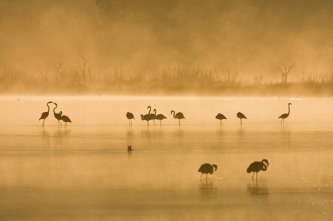
Flamingoes at the Gialova Lagoon in a winter morning
Gialova Lagoon, just a short walk away along the beach from Zoe Resort, is a brackish water coastal wetland.
During the 50’s attempts were made to drain it, as was the general policy at the time for all wetlands, but thanks to the abundance of underground water the plans failed. Perfect example of the mistakes of the recent past, its size was reduced by 1/3 and its ecosystem damaged by canals, ditches and roads. These interventions altered the natural course of the rivers and reduced its productivity. Nature, however, resists and the Gialova Lagoon remains today a rich ecosystem that gives refuge to a high variety of inhabitants. Among these there are over 270 species of birds, which include many rare species. Ospreys, Imperial Eagles, Marsh Harriers, Great White Egrets, Bitterns, Purple Herons, Glossy Ibises, terns, many ducks and waders and a multitude of passerines visit the wetland during migration and/or winter. Other species breed during the summer.
This abundance of birds makes the Gialova Lagoon the most important wetland at the southern tip of the Balkan Peninsula. See here more photos of the Gialova Lagoon and its wildlife.
During the 50’s attempts were made to drain it, as was the general policy at the time for all wetlands, but thanks to the abundance of underground water the plans failed. Perfect example of the mistakes of the recent past, its size was reduced by 1/3 and its ecosystem damaged by canals, ditches and roads. These interventions altered the natural course of the rivers and reduced its productivity. Nature, however, resists and the Gialova Lagoon remains today a rich ecosystem that gives refuge to a high variety of inhabitants. Among these there are over 270 species of birds, which include many rare species. Ospreys, Imperial Eagles, Marsh Harriers, Great White Egrets, Bitterns, Purple Herons, Glossy Ibises, terns, many ducks and waders and a multitude of passerines visit the wetland during migration and/or winter. Other species breed during the summer.
This abundance of birds makes the Gialova Lagoon the most important wetland at the southern tip of the Balkan Peninsula. See here more photos of the Gialova Lagoon and its wildlife.
Ecosystems of the Gialova Lagoon
A wetland is an ecosystem made up by a complex of smaller habitats, each characterized by water, soil and salt interaction, resulting in differentiated plant communities. A remarkable variety of strongly interdependent organisms develop, from invertebrates to fishes and a variety of birds, many of wich are rare and endangered today.
The lagoon
The main lagoon is mostly inundated by the sea. Thus salt resistant animal and plant life prevail and are preyed upon by certain species of fish and birds. It is a feeding place for ducks, coots, cormorants, ferns, herons, ospreys and flamingoes.
The marsh and the reedbed
Freshwater flows into the marsh from the river Tiphiomitis. Freshwater species (or partly so, such as eel) find refuge in this habitat. The reedbeds are a crucial breeding and feeding place for neonate fish. Many species of birds nest in the reeds (such as the Little Bittern) as the reedbeds are undisturbed by humans and inaccessible to most predators. The marsh is also a favourite foraging ground for Glossy Ibises, grebes, Marsh Harriers and Black-winged Stilts which breed on the islets among the reeds' clearings.
The lagoon
The main lagoon is mostly inundated by the sea. Thus salt resistant animal and plant life prevail and are preyed upon by certain species of fish and birds. It is a feeding place for ducks, coots, cormorants, ferns, herons, ospreys and flamingoes.
The marsh and the reedbed
Freshwater flows into the marsh from the river Tiphiomitis. Freshwater species (or partly so, such as eel) find refuge in this habitat. The reedbeds are a crucial breeding and feeding place for neonate fish. Many species of birds nest in the reeds (such as the Little Bittern) as the reedbeds are undisturbed by humans and inaccessible to most predators. The marsh is also a favourite foraging ground for Glossy Ibises, grebes, Marsh Harriers and Black-winged Stilts which breed on the islets among the reeds' clearings.
Waterfalls
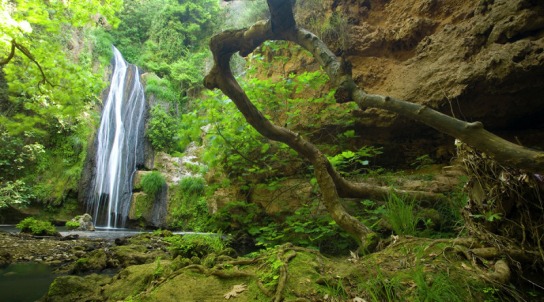
To the eye of the tourist used to famous Greek islands such as Mykonos and Santorini or to the region around Athens where the summer vegetation is low and dry, Gialova and its surroundings look surprisingly green. As a matter of fact, a lush Maquis vegetation grows all along the western coast of the Peloponnese, where in average it rains almost twice as much as in Athens or on the Cyclades.
Many valleys cut through the hills covered by olive groves and natural vegetation around Gialova, and some of them hide wonderful waterfalls, such as the Kalamari waterfall by Schinolaka (the closest to Gialova), Polilimnio by Kazarma and the waterfall of Valta near Gargalianoi.
All these waterfalls can be easily visited on foot along footpaths that have been purposely created.
Many valleys cut through the hills covered by olive groves and natural vegetation around Gialova, and some of them hide wonderful waterfalls, such as the Kalamari waterfall by Schinolaka (the closest to Gialova), Polilimnio by Kazarma and the waterfall of Valta near Gargalianoi.
All these waterfalls can be easily visited on foot along footpaths that have been purposely created.
